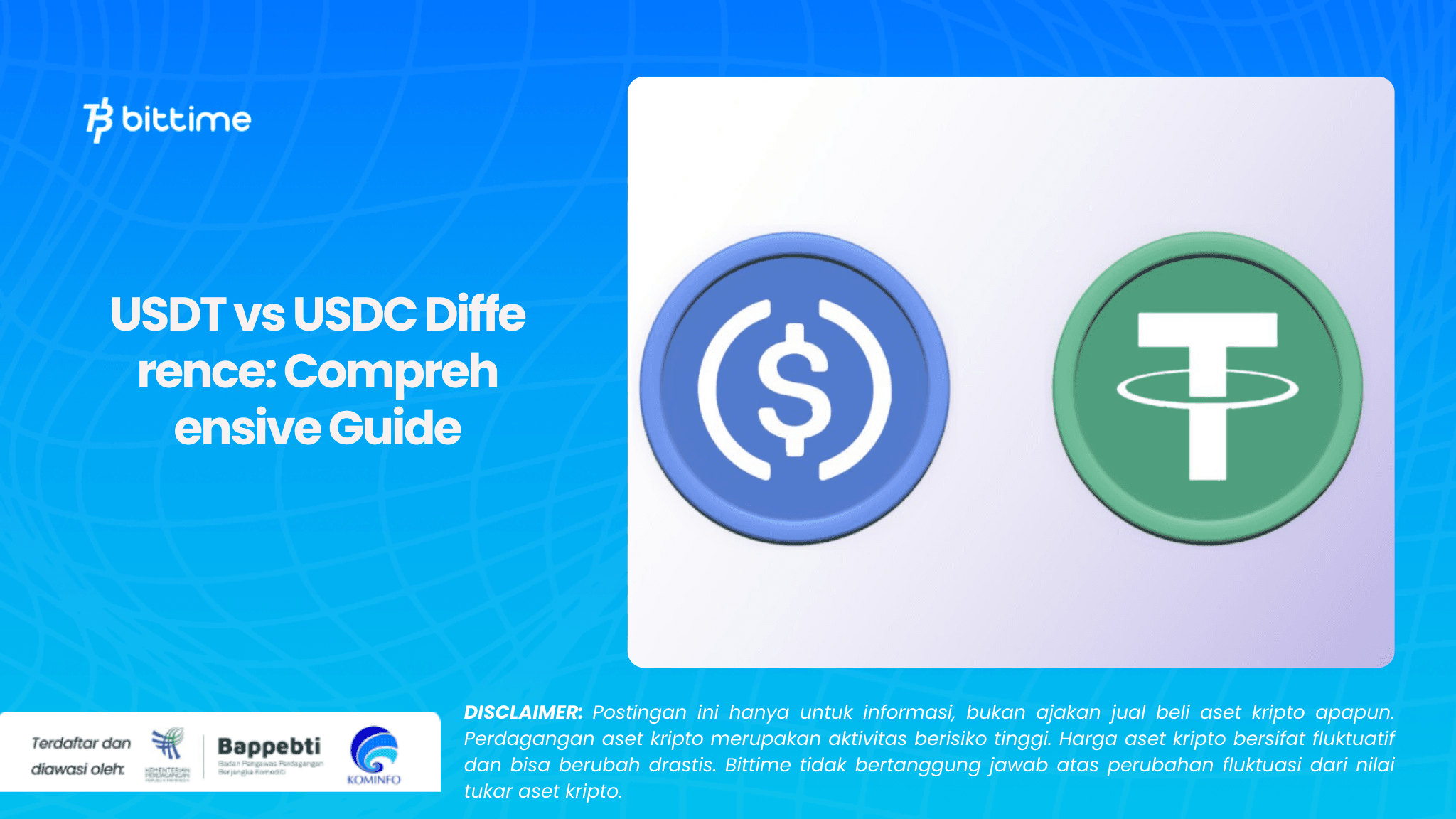USDT vs USDC Difference: Comprehensive Guide
2024-07-31
Bittime - Many facilities provided by stablecoin to investors in the crypto world, offers the stability and backing of fiat money, as well as the ability to transfer funds quickly on the blockchain network. Tether (USDT) and USD Coin (USDC) are two of the many stablecoins known in the crypto world.
To maintain value stability, both are fully supported by their respective reserve currencies. Nonetheless, there are some key differences that set them apart. In this article we will discuss and explore the similarities and differences between USDT and USDC.
What Are Stablecoins?
Stablecoins are an asset cryptocurrency whose value is pegged to fiat money or gold. Fiat-backed stablecoins are typically pegged to the US dollar at 1:1. As the name suggests, stablecoins have low volatility and stability compared to other crypto assets such as Bitcoin (BTC) and Ether (ETH). Here are some of the advantages of stablecoins, including:
- Fiat Support: Fiat currency support provides more security for investors because blockchain technology makes transactions safer and more secure.
- Availability: With unlimited time and available 24 hours, and without holidays, it is possible to maintain availability well.
- Flexibility: Stablecoins offer a way to send and receive unlimited payments quickly and easily.
- Stability: The value of stablecoins is said to be very stable, unlike other digital assets, meaning the price will generally remain the same as traditional fiat currencies.
- Fast Transaction: Stablecoin transactions are usually instant, as opposed to deposits in regular currencies which take a long time to appear in bank accounts.
- Low Transaction Fees: Stablecoins offer the opportunity for low-cost transactions, with some even providing no-fee trading, transfers and conversions.
- Transparency: Many stablecoins are transparent, allowing users to see whether there are enough assets in reserve to redeem them.
USDT: Tether
With a market capitalization of over $69 billion, USDT is one of the most popular stablecoins today. The stablecoin was issued by Tether Limited, a company owned by Hong Kong-based iFinex, which also owns crypto exchange BitFinex.
USDT is pegged to the US dollar on a 1:1 basis, and each USDT token is backed by an asset held in reserve. Thus, USDT can be spent, transferred, or exchanged like any other fiat currency.
Cek Market Crypto Hari Ini:
Tether is one of the first cryptocurrencies that can overcome blockchain-related challenges, such as facilitating the transfer of national currencies and providing a method for checking the value of tokens. Although USDT has faced controversy surrounding reserve management and degree of decentralization, it remains one of the most widely used stablecoins on the market, accepted by many exchanges, and compatible with several wallet.
In an effort to address concerns around Tether's stability, the company leading Tether is also more clearly disclosing its cash reserves through monthly transparency reports.
USDC: USD Coin
USDC is a stablecoin that is also backed by the US dollar and was developed to reduce the volatility of Bitcoin and other crypto assets through faster fund transfers. USDC, created by Circle Internet Financial, is an Ethereum token that can be transferred to the Ethereum blockchain or stored in a crypto wallet.
USDC is fully collateralized and transparent, meaning they are very open about their ecosystem and reserves. USDC tokens can be redeemed 1:1 dollars through regulated financial institutions that partner with Circle. These financial institutions are required to undergo monthly audits and attestations to ensure that reserve amounts are sufficient, increasing trust and transparency in the value of stablecoins.
With over $42 billion in circulation and support from leading exchanges and wallets such as Coinbase and Gemini, USDC has grown multichain and is available natively on blockchains such as Polygon, Avalanche, Algorand, Solana, Hedera, and Tron, among others.
Difference between USDT vs USDC
TheThere are several important differences between USDT and USDC. USDT was issued by Tether Limited in 2014 and is the oldest stablecoin with a very high daily trading volume.
However, Tether often faces criticism regarding the lack of transparency and auditing of their asset reserves. On the other hand, USDC launched in 2018 by Circle and Coinbase, managed by the Center consortium, is known for its higher level of transparency and regular audits by large accounting firms.
Another major difference is in terms of regulations and compliance. USDT has experienced several legal and regulatory issues, especially regarding reserves and transparency. Despite this, USDT remains the most traded stablecoin.
On the other hand, USDC is designed to adhere to strict regulatory standards and work closely with regulators, making it preferred by institutions and consumers who care about legal compliance.
In terms of usage, USDT offers high liquidity and wide adoption across various crypto exchanges, while USDC is also gaining significant adoption, especially among institutions. Both are available on various blockchains, allowing for flexibility in fees and transaction speed.
Choosing between USDT and USDC depends on user needs and preferences, taking into account factors such as liquidity, transparency, and compliance.
How to Buy Crypto on Bittime
You can buy and sell crypto assets in an easy and safe way through Bittime. Bittime is one of the best crypto applications in Indonesia which is officially registered with Bappebti.
To be able to buy crypto assets on Bittime, make sure you have registered and completed identity verification. Apart from that, also make sure that you have sufficient balance by depositing some funds into your wallet. For your information, the minimum purchase of assets on Bittime is IDR 10,000. After that, you can purchase crypto assets in the application. Study Complete Guide How to Buy Crypto on Bittime.
Monitor graphic movement Bitcoin (BTC) price, Ethereum (ETH), Solana (SOL) and other cryptos to find out today's crypto market trends in real-time on Bittime.
Disclaimer: The views expressed belong exclusively to the author and do not reflect the views of this platform. This platform and its affiliates disclaim any responsibility for the accuracy or suitability of the information provided. It is for informational purposes only and not intended as financial or investment advice.





